Gymnopus bunerensis Ishaq, M, Fiaz, M & Khalid sp. nov. Fig. 64,65
MycoBank number: MB 829211; Index Fungorum number: IF 829211; Facesoffungi number: FoF 10621;
Etymology –“bunerensis” refers to the holotype locality i.e. Buner District.
Diagnosis – Campanulate, fibrillose pileus with incurved margins that becomes saucer-shaped with eroded margins at maturity, relatively smaller basidiospores (4.3−5.9 × 2.7−3.7 µm), narrowly clavate to clavate basidia (11−23 × 5−6 µm), narrowly fusiform to fusiform cheilocystidia and irregularly shaped caulocystidia.
Holotype – Pakistan, Khyber Pakhtunkhwa Province, Malakand division, Buner district, 34°09’N, 34°–43’N and 72°10’E, 72°47′ E, 3183 m a.s.l, on soil under Pinus roxburghii, 17 July 2017, Muhammad Ishaq (LAH35878; GenBank ITS: MK122772; LSU: MK122770).
Basidiocarps medium-sized, Pileus 20−40 mm in diam., initially campanulate, becoming saucer-shaped at maturity, somewhat depressed at the disk, margin incurved when young, uplifted with maturity, eroded; surface fibrillose, reddish brown (7.5R4/8) at center, violet-brown (5YR5/4) towards margin, plicate-striate. Lamellae 0.5−1 mm broad, adnate, unequal, with entire margin, creamy to pale yellow (10YR8/4); distant to subdistant with unevenly distributed lamellulae. Stipe 20−40 × 2−4 mm, central, terete to somewhat equal, minutely pubescent, dark reddish brown, basal mycelium absent. Smell unpleasant.
Basidiospores [n/b/p] [60/3/2] (3.6−) 4.3−5.9 (−6.3) × (2.4−) 2.7−3.7 (−3.9) µm, L × W = 4.9 × 3.1 µm, Q = (1.2−) 1.4−1.8 (−2), Qe = 1.6, oblong, subcylindrical to ellipsoid, smooth, thin-walled, hyaline in KOH, inamyloid; apiculus small. Basidia 11−23 × 5−6 µm, narrowly clavate to clavate, thin-walled, hyaline in 5% KOH, inamyloid, 2–4-spored; sterigmata 7−10 µm long. Cheilocystidia 14−23 × 4−5 µm, narrowly fusiform to fusiform, thin-walled, brown in 5% KOH, oil granules present with KOH. Pileipellis composed of hyphae, 6−8 µm wide, thick-walled (0.5−0.8 µm) sometimes with diverticulate outgrowths, radially oriented, branched. Stipitipellis hyphae 3−6 µm wide, parallelly arranged, thick-walled (0.6−1 µm), cylindrical to subcylindrical, branched, sometimes with diverticulate outgrowths. Caulocystidia 29−71 × 3−5 µm, narrowly clavate to narrowly conical, obtuse, seldom lobed, strangulated or irregular shape, thick-walled (0.7−0.9). Clamp-connections present in all the tissues.
Habitat – Frequently grows on decayed materials of leaves and branches of Pinus roxburghii Sargent, in coniferous forests.
Additional specimen (paratype) examined – Pakistan, Khyber Pakhtunkhwa Province, Hazara division, Battagram district, 34°33′ and 34°47′ latitude and 72°55′ and 73°14′ longitude, at 2085 a.s.l., 07 August 2016, Muhammad Binyamin Khan (LAH35877).
Notes – Morphologically, Gymnopus bunerensis is similar to G. similis Antonín, Ryoo, Ka and Tomšovský (2016: 268) but G. similis differs by its larger basidiospores (6‒9 × 2.7–4 μm), and the presence of irregular to rostrate or coralloid cheilocystidia (Ryoo et al. 2016). A phylogenetically close taxon G. variicolor Antonín, Ryoo, Ka and Tomšovský (2016: 268) is distinct by the striate to striate-sulcate, purplish brown, dark to reddish brown pileus and larger stipe (30–80 × 2.5–5 mm) of violaceous brown to reddish brown color and basidiospores (6‒8.5 × 3.2–4.5 μm) compared to G. bunerensis (Ryoo et al. 2016). Gymnopus iocephalus (Berk. and Curtis) Halling (1997: 364) is distinct from the new species and differs by its purplish lilac, vinaceous lilac, light pinkish lilac to pale vinaceous lilac pileus, larger basidiospores (6.5‒8.6 × 3.2‒4.4 μm) and absence of cheilocystidia (Halling 2004). Gymnopus impudicus (Fr.) Antonín, Halling and Noordel. (1997: 364) differs from G. bunerensis by a combination of characters viz., smaller pileus (10–25 mm diam.), larger basidiospores (6.4−10.9 × 3.5−4.8 μm) and larger basidia (30.7−34.5 × 5.7−6.2 μm) (Antonín and Noordeloos 1997). Another phylogenetically close taxon G. talisiae V. Coimbra, Pinheiro, Wartchow and Gibertoni (2015: 110) is morphologically distinct as it has a larger pileus (20–60 mm) with a smooth pale greyish orange, brownish orange, light brown to brown surface. Furthermore, it has yellowish white, orange-white, orange-grey to reddish blond lamellae, as well as a larger stipe (30–70 × 2–5 mm), basidiospores (4–) 5–8 × 2–4 μm, and basidia 23–29 × 5–7 μm (Coimbra et al. 2015).

Figure 64 – Basidiocarps of A. Gymnopus ocior; B. G. bunerensis; C. Collybiopsis biformis; D. G. subnudus in the field. Scale bars: A-D=50 mm.

Figure 65 – Gymnopus bunerensis (LAH35878; Holotype). A Basidia. B Basidiospores. C Cheilocystidia. D Pileipellis. E Caulocystidia. Drawings by Muhammad Ishaq. Scale bars: A,C, D, E= 20 μm, B= 10 μm.
